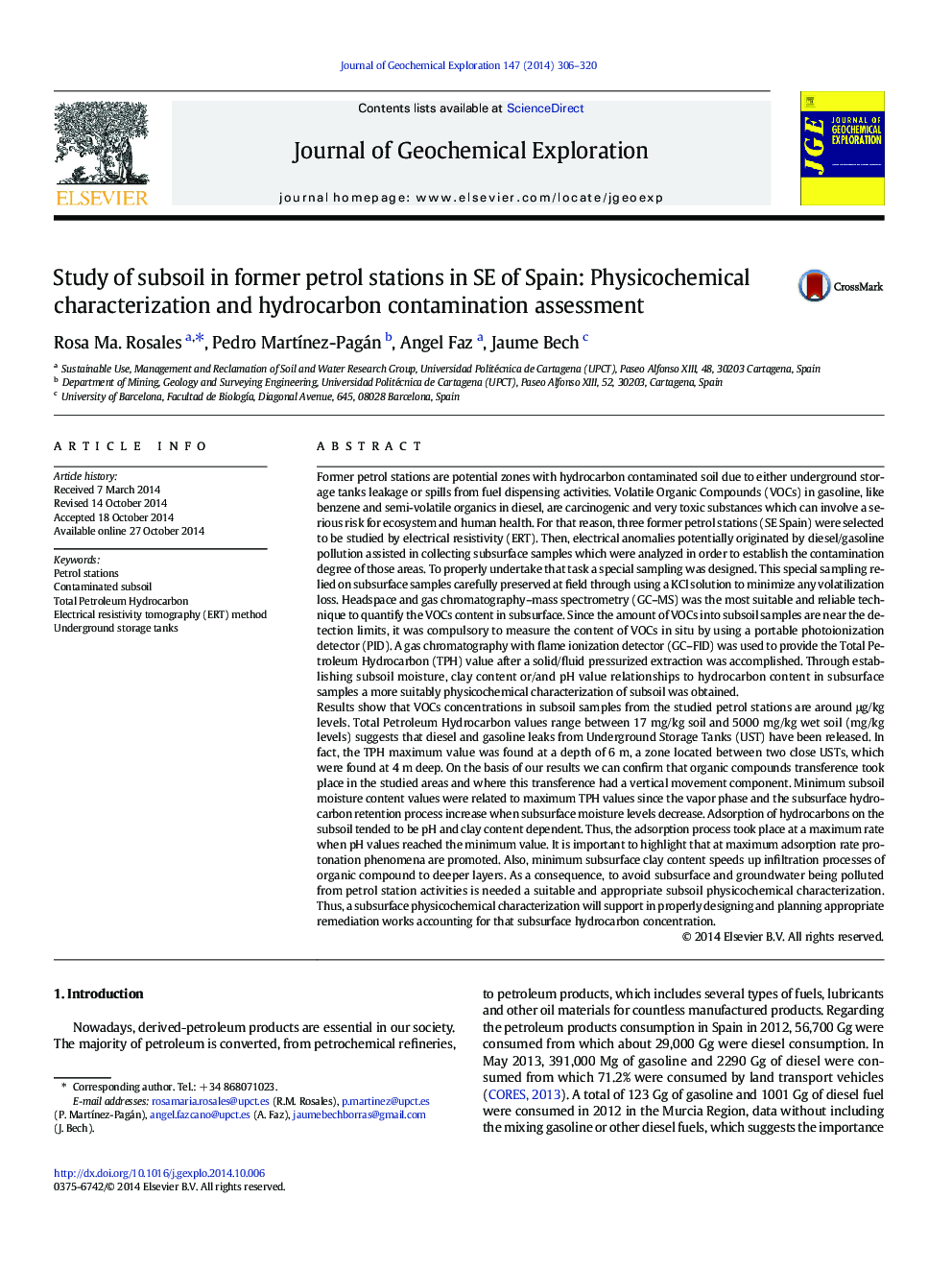| Article ID | Journal | Published Year | Pages | File Type |
|---|---|---|---|---|
| 4457231 | Journal of Geochemical Exploration | 2014 | 15 Pages |
•Detection and quantification of petroleum hydrocarbons at former petrol stations•Electrical Resistivity Tomography minimizes the cost and uncertainty in the sampling.•Maximum hydrocarbon concentration at 6 m deep, gets 5000 mg TPH/kg wet soil.•Relationship between low electrical resistivity anomalies and petroleum hydrocarbons•Maximum hydrocarbon concentration is related to a decrease in the subsurface moisture.
Former petrol stations are potential zones with hydrocarbon contaminated soil due to either underground storage tanks leakage or spills from fuel dispensing activities. Volatile Organic Compounds (VOCs) in gasoline, like benzene and semi-volatile organics in diesel, are carcinogenic and very toxic substances which can involve a serious risk for ecosystem and human health. For that reason, three former petrol stations (SE Spain) were selected to be studied by electrical resistivity (ERT). Then, electrical anomalies potentially originated by diesel/gasoline pollution assisted in collecting subsurface samples which were analyzed in order to establish the contamination degree of those areas. To properly undertake that task a special sampling was designed. This special sampling relied on subsurface samples carefully preserved at field through using a KCl solution to minimize any volatilization loss. Headspace and gas chromatography–mass spectrometry (GC–MS) was the most suitable and reliable technique to quantify the VOCs content in subsurface. Since the amount of VOCs into subsoil samples are near the detection limits, it was compulsory to measure the content of VOCs in situ by using a portable photoionization detector (PID). A gas chromatography with flame ionization detector (GC–FID) was used to provide the Total Petroleum Hydrocarbon (TPH) value after a solid/fluid pressurized extraction was accomplished. Through establishing subsoil moisture, clay content or/and pH value relationships to hydrocarbon content in subsurface samples a more suitably physicochemical characterization of subsoil was obtained.Results show that VOCs concentrations in subsoil samples from the studied petrol stations are around μg/kg levels. Total Petroleum Hydrocarbon values range between 17 mg/kg soil and 5000 mg/kg wet soil (mg/kg levels) suggests that diesel and gasoline leaks from Underground Storage Tanks (UST) have been released. In fact, the TPH maximum value was found at a depth of 6 m, a zone located between two close USTs, which were found at 4 m deep. On the basis of our results we can confirm that organic compounds transference took place in the studied areas and where this transference had a vertical movement component. Minimum subsoil moisture content values were related to maximum TPH values since the vapor phase and the subsurface hydrocarbon retention process increase when subsurface moisture levels decrease. Adsorption of hydrocarbons on the subsoil tended to be pH and clay content dependent. Thus, the adsorption process took place at a maximum rate when pH values reached the minimum value. It is important to highlight that at maximum adsorption rate protonation phenomena are promoted. Also, minimum subsurface clay content speeds up infiltration processes of organic compound to deeper layers. As a consequence, to avoid subsurface and groundwater being polluted from petrol station activities is needed a suitable and appropriate subsoil physicochemical characterization. Thus, a subsurface physicochemical characterization will support in properly designing and planning appropriate remediation works accounting for that subsurface hydrocarbon concentration.
